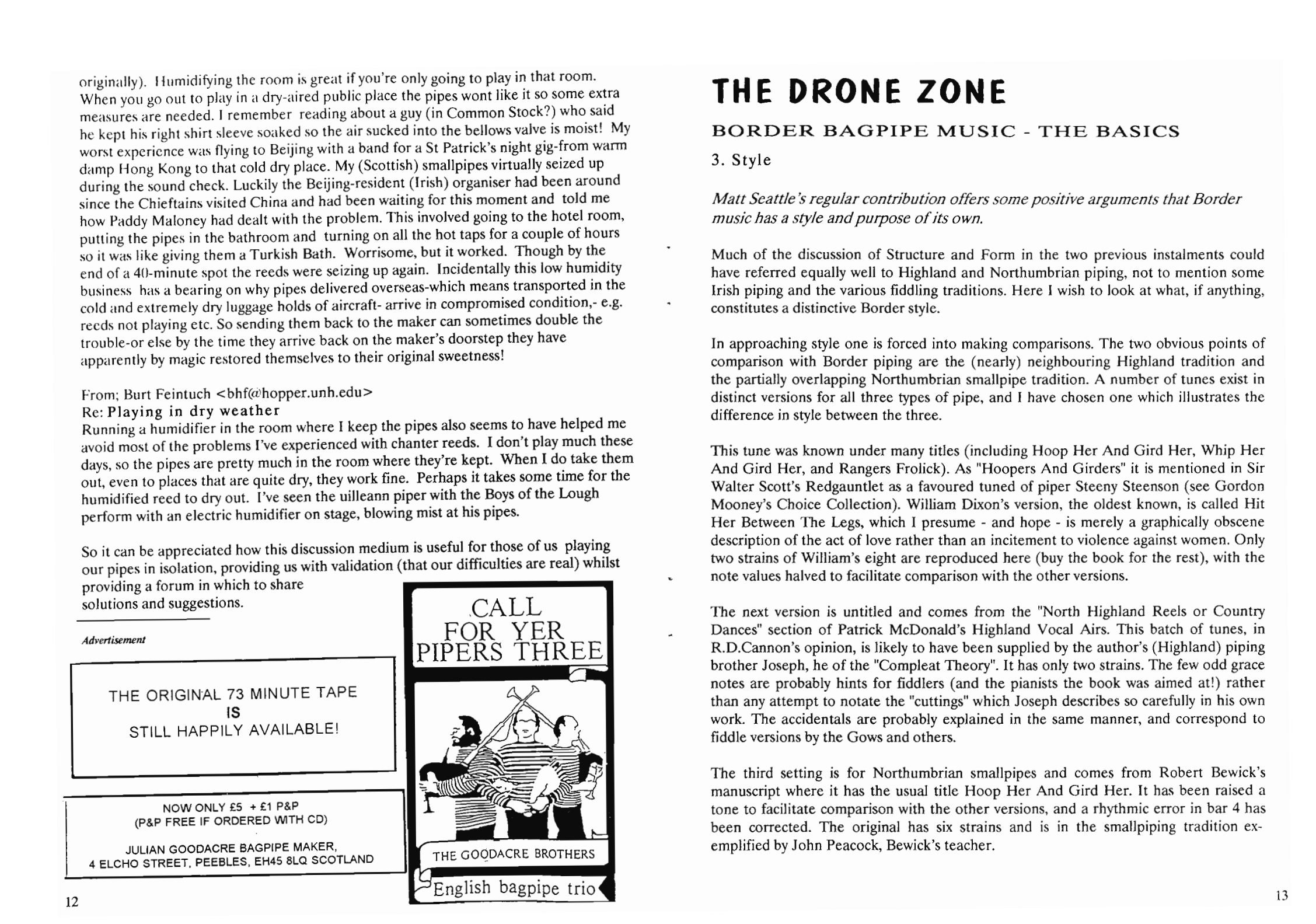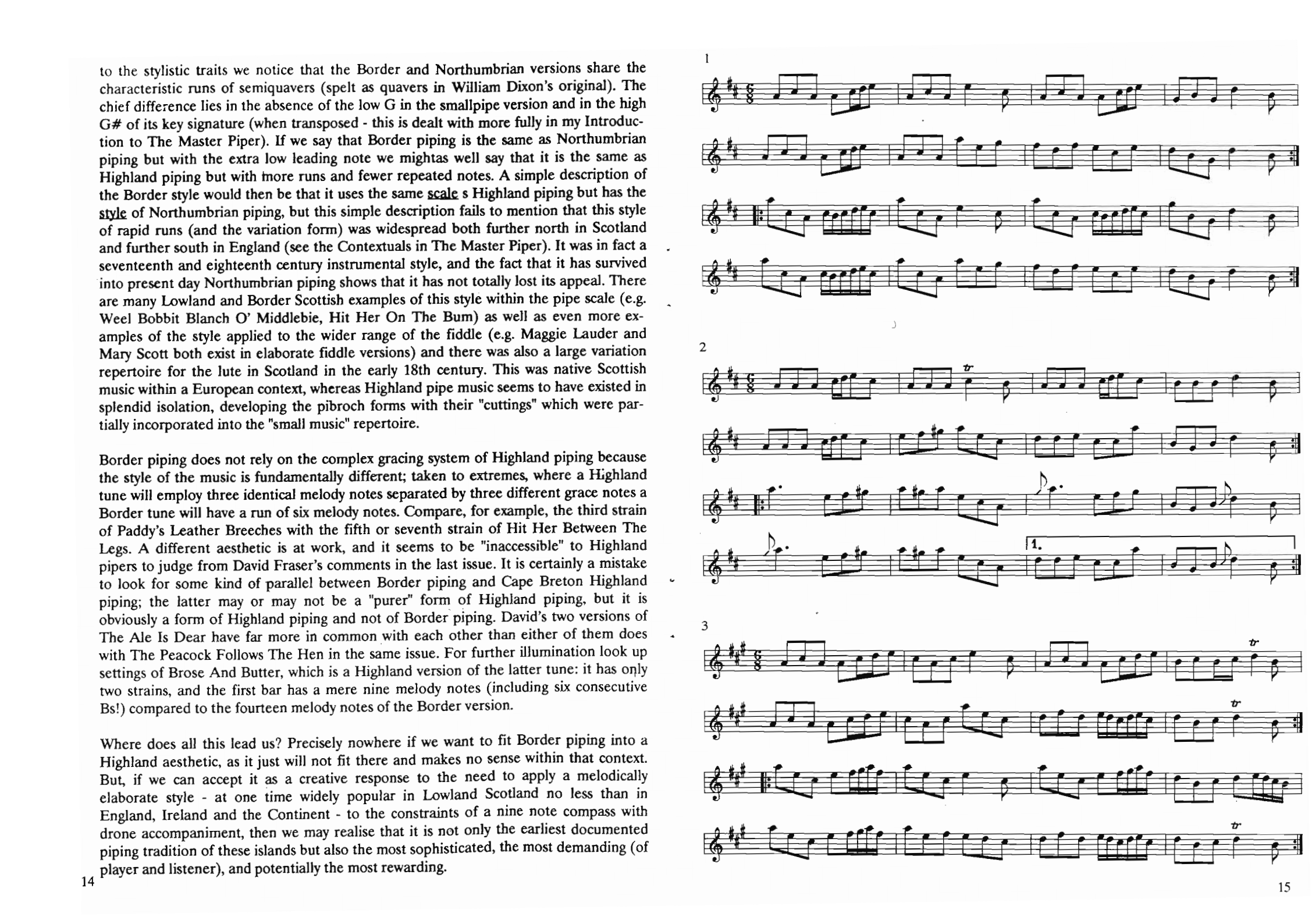Border Bagpipe Music - The Basics 3


BORDER BAGPIPE MUSIC - THE BASICS 3. Style
Matt Seattle’s regular contribution offers some positive arguments that Border music has a style and purpose of its own.
Much of the discussion of Structure and Form in the two previous instalments could have referred equally well to Highland and Northumbrian piping, not to mention some Irish piping and the various fiddling traditions. Here I wish to look at what, if anything, constitutes a distinctive Border style.
In approaching style one is forced into making comparisons. The two obvious points of comparison with Border piping are the (nearly) neighbouring Highland tradition and the partially overlapping Northumbrian smallpipe tradition. A number of tunes exist in distinct versions for all three types of pipe, and I have chosen one which illustrates the difference in style between the three.
This tune was known under many titles (including Hoop Her And Gird Her, Whip Her And
Gird Her, and Rangers Frolick). As “Hoopers And Girders” it is mentioned in Sir Walter
Scott’s Redgauntlet as a favoured tuned of piper Steeny Steenson (see Gordon Mooney’s
Choice Collection). William Dixon’s version, the oldest known, is called Hit Her Between The Legs, which I presume - and hope - is merely a graphically obscene description of the
act of love rather than an incitement to violence against women. Only two strains of William’s eight are reproduced here (buy the book for the rest), with the note values halved to facilitate comparison with the other versions.
The next version is untitled and comes from the “North Highland Reels or Country Dances” section of Patrick McDonald’s Highland Vocal Airs. This batch of tunes, in R.D. Cannon’s opinion, is likely to have been supplied by the author’s (Highland) piping brother Joseph, he of the “Compleat Theory”. It has only two strains. The few odd grace notes are probably hints for fiddlers (and the pianists the book was aimed at!) rather than any attempt to notate the “cuttings” which Joseph describes so carefully in his own work. The accidentals are probably explained in the same manner, and correspond to fiddle versions by the Gows and others.
The third setting is for Northumbrian smallpipes and comes from Robert Bewick’s manuscript where it has the usual title Hoop Her And Gird Her. It has been raised a tone to facilitate comparison with the other versions, and a rhythmic error in bar 4 has been corrected. The original has six strains and is in the smallpiping tradition exemplified by John Peacock, Bewick’s teacher. (opening text missing in original for following sentence) to the stylistic trails we notice that the Border and Northumbrian versions share the
characteristic runs of semiquavers (spelt as quavers in William Dixon’s original). The chief difference lies in the absence of the low G in the smallpipe version and in the high G# of its key signature (when transposed - this is dealt with more fully in my Introduction to The Master Piper). If we say that Border piping is the same as Northumbrian piping but with the extra low leading note we might as well say that it is the same as Highland piping but with more runs and fewer repeated notes. A simple description of the Border style would then be that it uses the same scale as Highland piping but has the style of Northumbrian piping, but this simple description fails to mention that this style of rapid runs (and the variation form) was widespread both further north in Scotland and further south in England (see the Contextuals in The Master Piper). It was in fact a seventeenth and eighteenth century instrumental style, and the fact that it has survived into present day Northumbrian piping shows that it has not totally lost its appeal. There are many Lowland and Border Scottish examples of this style within the pipe scale (e.g. Weel Bobbit Blanch O’ Middlebie, Hit Her On The Bum) as well as even more examples of the style applied to the wider range of the fiddle (e.g. Maggie Lauder and Mary Scott both exist in elaborate fiddle versions) and there was also a large variation repertoire for the lute in Scotland in the early 18th century. This was native Scottish music within a European context, whereas Highland pipe music seems to have existed in splendid isolation, developing the pibroch forms with their “cuttings” which were partially incorporated into the “small music” repertoire.
Border piping does not rely on the complex gracing system of Highland piping because the style of the music is fundamentally different; taken to extremes, where a Highland tune will employ three identical melody notes separated by three different grace notes a Border tune will have a run of six melody notes. Compare, for example, the third strain of Paddy’s Leather Breeches with the fifth or seventh strain of Hit Her Between The Legs. A different aesthetic is at work, and it seems to be “inaccessible” to Highland pipers to judge from David Fraser’s comments in the last issue. It is certainly a mistake to look for some kind of parallel between Border piping and Cape Breton Highland piping; the latter may or may not be a “purer” form of Highland piping, but it is obviously a form of Highland piping and not of Border piping. David’s two versions of The Ale Is Dear have far more in common with each other than either of them does with The Peacock Follows The Hen in the same issue. For further illumination look up settings of Brose And Butter, which is a Highland version of the latter tune: it has only two strains, and the first bar has a mere nine melody notes (including six consecutive Bs!) compared to the fourteen melody notes of the Border version.
Where does all this lead us? Precisely nowhere if we want to fit Border piping into a Highland aesthetic, as it just will not fit there and makes no sense within that context. But, if we can accept it as a creative response to the need to apply a melodically elaborate style - at one time widely popular in Lowland Scotland no less than in England, Ireland and the Continent - to the constraints of a nine note compass with drone accompaniment, then we may realise that it is not only the earliest documented piping tradition of these islands but also the most sophisticated, the most demanding (of 14 player and listener), and potentially the most rewarding.
